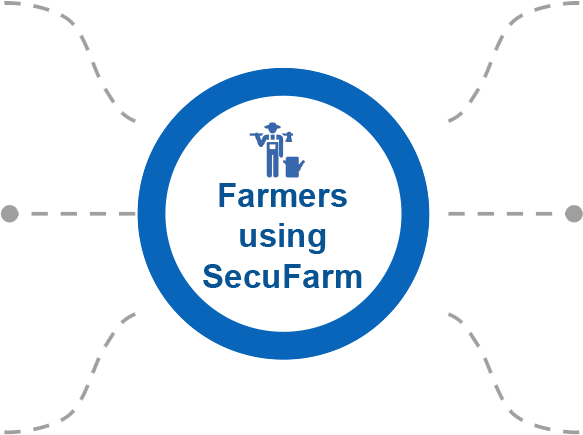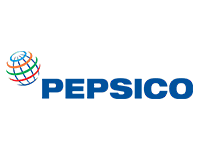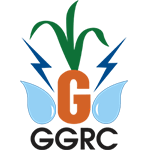SecuFarm is the world’s first smart & sustainable farming solution that provides a guaranteed income to the farmers.
What is SecuFarm?

Why SecuFarm?
Benefits of SecuFarm
Enhanced Yield
SecuFarm helps farmers enhance crop yield. Information is gathered using IoT Sensors (AWS, AIS, APM, & ASM), satellites & drones, and GPS-enabled smartphones. This information is processed using Big Data Analysis, Machine Learning, & Image Processing techniques to provide weather & disease alerts, farm advisory, and farm management inputs to the farmers through mobile application & SMS.
Guaranteed Income
SecuFarm helps the farmers ensure crop protection and secure a better yield. Should the farmers fall short of meeting the expected amount of yield, they are guaranteed a minimum farm income which aids in compensation payouts.
Sustainable Farming
SecuFarm helps farmers undertake sustainable farming, i.e., environment-friendly farming by providing guidance on how to optimally use water and agricultural chemicals.
How Farmers Experience SecuFarm


Farmer enrols with WRMS to create a SecuFarm.


Geo-tagged farms are analysed to offer the farmers income guarantee against a fee based on soil, water, & climatic conditions.


Farmer has to follow a smart and sustainable farming plan called the Package of Practices (PoP) which assures yield.


After yield assessment, the farmer is compensated if the yield is below the assured yield despite following the PoP.


WRMS monitors the on-ground situation using satellites & IoT and accordingly provides real-time assistance.


WRMS forecasts pest attacks, diseases, and weather risk to provide risk management inputs.


WRMS assists in selling the produce to modern trade who value sustainable farming practices and give a better price.


With a guaranteed income, farmers feel confident to invest in smart farming technology and get enhanced productivity.
Multi-Stakeholder Proposition

Key Features
- WRMS’s on-ground team geo-tags the farms
- Soil is analysed in privately-owned soil testing labs to identify the necessary nutrients that the soil lacks
- Based on the market demand assessment, the best seed variety for higher market price is identified
- Water hardness is measured and an optimal water demand is assessed
-
- Satellites, drones, and IoT sensors are used to monitor the geo-tagged farms
- Data captured is analysed using image processing and AI / ML to generate forecasts & alerts for weather, pests, and crop diseases
- Timely alerts, farm advisory, crop stress status, & soil management protocols are shared on the SecuFarm mobile application & SMSs in vernacular languages
- Farmers are provided access to machinery, i.e mechanized planters & harvesters for reducing time & improving efficiency
- Automatic Weather Station (AWS): Helps in generating weather forecasts using grid-level data captured for the following parameters:
- Air Temperature
- Relative Humidity
- Precipitation & Hailstorms
- Wind Speed & Direction
- Solar Radiation
- Barometric Pressure
- Evaporation
- Soil Moisture
- Automatic Pest Monitor (APM): Monitors all kind of pests and provides the pest density remotely by attracting the pest & capturing the images
- Automatic Soil Moisture (ASM) sensor: Provides real-time analysis of the soil health – soil moisture, physical properties, structure, and nutrient contents of soil – of a particular area
Remote sensing technology helps to remotely monitor the crop health by capturing, storing, manipulating, analyzing, managing, and presenting spatial or geographic data related to:
- Normalized Difference Vegetation Index (NDVI)
- Normalized Difference Water Index (NDWI)
AI technology & deep learning is applied on historical data of weather, yield, etc to provide estimated values of present data wherever other sensors are unable to capture real-time data
- Hotbeds of pests are identified using historical data of pesticide sales, pest outbreak, and conducive weather conditions
- Wind-based migration of pests is tracked using AWSs
- Electronic pest traps are deployed at the farms to capture the live pest data
Using a combination of IoT devices, farmers can use the water optimally, thus preventing water table depletion, soil erosion, and crop damage.
- Automatic Weather Stations (AWSs) help in forecasting rainfall
- Automatic Soil Moisture (ASM) sensors provide real-time soil moisture data
- Automatic Irrigation Switches (AISs) help farmers to remotely control the irrigation pump
- GPS-enabled live-tracking of spraying & harvesting pattern of the field and monitoring speed, flow-rate , & pressure
- Dashboard for viewing reports to track the proper utilization of machines
- Logistics Management System for market linkages using IoT and blockchain architecture
- Traceability solutions using QR coding & blockchain architecture
Assistance in gradation, packaging, storing, logistics, and getting best market prices
Our Happy Clients





SecuFarm Success Stories

Background
Late Blight is a lethal potato disease. In 2006 PepsiCo contract farmers lost 60 % of their crops due to this bane. It was difficult to extend cover under existing Crop Insurance programs due to moral hazard.
What we did
- Analyzed & found high correlations between location, humidity, and temperature.
- Created an index to cover blight risk specific to the region
- Installed weather stations to minimize basic risk; critical for extending this kind of cover
Impact
-

Successfully ran the project for 10+ years
-

Covered 10000+ potato farmers
-

Enabled risk-free investment of small & marginal farmers in smart technology
-

Demonstrated how insurance can be used by contract farming companies to sustain their farmer base
